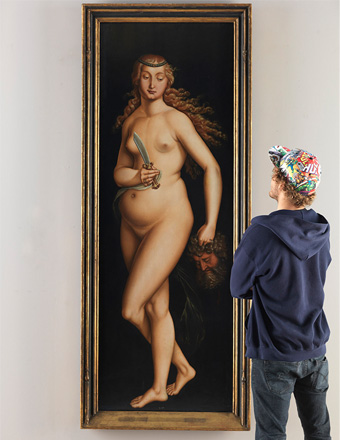Fragen und Antworten

Why is the Museum called “germanisch”?
The museum was founded in 1852 to document the culture of the “Germanic cultural area”. In the 19th century, this was understood as the areas in which at one time German was spoken – the field of study known as “Germanistik” is also derived from this. The foundation of the museum intended to document the unity of the German-speaking cultural areas in view of the failed political unification of German states in 1848. In the early era of national states this was not conceived as chauvinism but was instead a progressive concept.
Who finances the Museum?
The Federal Republic of Germany, the Free State of Bavaria and the city of Nuremberg are the funding sources for the Germanisches Nationalmuseum. The museum is a foundation under public law; as a non-university research institute of national significance, it is represented by the Leibniz Association (Leibniz-Gemeinschaft) which evaluates it on a regular basis.
How can I donate to the museum?
For small contributions there is a glass case next to the ticket counter. Larger amounts may be donated in your capacity as member or sponsor of the museum. If you have any questions pertaining to the Stiftung zur Förderung des Germanischen Nationalmuseums (Foundation for the Support of the Germanisches Nationalmuseum), please contact us.
Where do I get information?
You can reach us at +49 (0)911-1331-0; advance ticket reservations at +49 (0)911 -1331-201. Or send an e-mail. The quarterly program is available at the ticket counter and can be downloaded from the website. Members and sponsors receive it in the mail.
Whom may I contact in case of criticism or suggestions?
You can write to us; see contact form
We encourage suggestions and will also attend to your complaints, taking care of them if possible. Generally, however, we adhere to the principle: Even we in the Germanisches Nationalmuseum are only human.
May I take photographs in the museum?
In the permanent collections you may take photographs at any time without flash or tripod. If you need a tripod, you will have to apply for permission in the press office. Photography is not permitted in special exhibitions since the lenders of works of art have their own rules. If you plan to take photos for commercial purposes, you need to contact the press office in any case.
Where can I obtain photos of exhibited objects?
The Museum Shop has a large number of postcards of exhibited objects. For scholarly or commercial purposes, please contact the Photographic Services, which administers reproduction rights. Press photos can be obtained from our Press Centre or Press Office.
May I take my bag into the exhibition?
As in most museums, there is a size restriction on bags. If the bag is larger than 210 x 294 mm (= DIN A4, i.e. standard European paper size), it has to be checked at the cloak room or put into a locker. Please support the security guards by not carrying coats over your arm or backpacks on your back. It is not permitted to carry food or drinks into the galleries. Questions should be directed to the guard or the personnel at the ticket counter.
Is the Museum suitable for handicapped visitors?
You can visit almost all galleries in a wheelchair via ramps or lifts, sometimes however not on the most direct path. The guards will gladly help you.
Does the Museum have a parking lot? Are there parking spaces for buses?
There are city parking garages in the immediate vicinity of the Museum, e.g. below the Kornmarkt. Parking spaces for buses are available in the Grasergasse, directly at the Museum. The Museum does not have its own parking spaces.
May I celebrate my birthday party in the Museum?
The Museum has several rooms which may be rented for private parties. At the same time, the “Kunst- und Kulturpädagogisches Zentrum” organizes children’s birthdays in the Museum. More information
How many objects are in the collection?
Altogether, the Museum holds 1.3 million objects (including the holdings of the library and the Department of Prints and Drawings). Of these approximately 25,000 are exhibited.
Can I have my own objects appraised?
Twice yearly the Museum conducts appraisals. Curators and conservators examine your treasures, classifying them art historically and giving advice on the best possible treatment. They will not offer information about value. Advance registration is not required.
How do I obtain a guided tour?
The Education Department of the museums in Nuremberg (KPZ) has worked out an extensive program of guided tours which you may consult in the GNM’s quarterly program or on the homepage of the KPZ. On Tuesdays to Saturdays at 10:30 and 15:00 (3:00 pm), and on Sundays and holidays at 15:00 (3:00 pm) general museum tours are conducted free of charge (the tours are held in German).
Beyond that, you may book tours for groups at any time by calling +49 (0)911-1331-238.
Are audio guides available?
Yes, you may rent audio guides at the ticket counter. They are available in German and English.
Why is the Museum closed on Mondays?
Mondays are used for the maintenance and cleaning of the collections as well as examination of objects.
